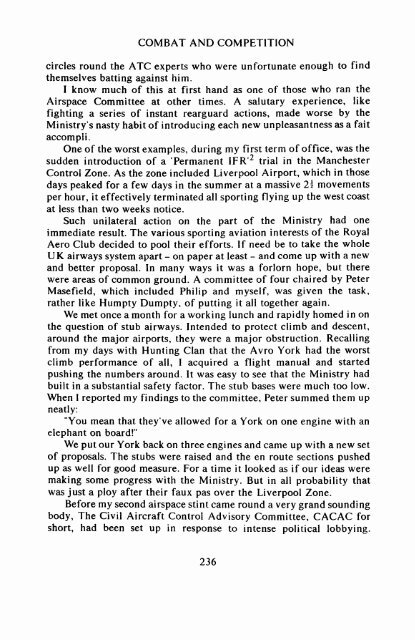COMBAT AND COMPETITION.pdf - Lakes Gliding Club
COMBAT AND COMPETITION.pdf - Lakes Gliding Club
COMBAT AND COMPETITION.pdf - Lakes Gliding Club
You also want an ePaper? Increase the reach of your titles
YUMPU automatically turns print PDFs into web optimized ePapers that Google loves.
<strong>COMBAT</strong> <strong>AND</strong> <strong>COMPETITION</strong><br />
circles round the ATC experts who were unfortunate enough to find<br />
themselves batting against him.<br />
I know much of this at first hand as one of those who ran the<br />
Airspace Committee at other times. A salutary experience, like<br />
fighting a series of instant rearguard actions, made worse by the<br />
Ministry's nasty habit of introducing each new unpleasantness as a fait<br />
accompli.<br />
One of the worst examples, during my first term of office, was the<br />
sudden introduction of a 'Permanent IFR' 2 trial in the Manchester<br />
Control Zone. As the zone included Liverpool Airport, which in those<br />
days peaked for a few days in the summer at a massive 21 movements<br />
per hour, it effectively terminated all sporting flying up the west coast<br />
at less than two weeks notice.<br />
Such unilateral action on the part of the Ministry had one<br />
immediate result. The various sporting aviation interests of the Royal<br />
Aero <strong>Club</strong> decided to pool their efforts. If need be to take the whole<br />
UK airways system apart - on paper at least - and come up with a new<br />
and better proposal. In many ways it was a forlorn hope, but there<br />
were areas of common ground. A committee of four chaired by Peter<br />
Masefield, which included Philip and myself, was given the task,<br />
rather like Humpty Dumpty, of putting it all together again.<br />
We met once a month for a working lunch and rapidly homed in on<br />
the question of stub airways. Intended to protect climb and descent,<br />
around the major airports, they were a major obstruction. Recalling<br />
from my days with Hunting Clan that the Avro York had the worst<br />
climb performance of all, I acquired a flight manual and started<br />
pushing the numbers around. It was easy to see that the Ministry had<br />
built in a substantial safety factor. The stub bases were much too low.<br />
When I reported my findings to the committee, Peter summed them up<br />
neatly:<br />
"You mean that they've allowed for a York on one engine with an<br />
elephant on board!"<br />
We put our York back on three engines and came up with a new set<br />
of proposals. The stubs were raised and the en route sections pushed<br />
up as well for good measure. For a time it looked as if our ideas were<br />
making some progress with the Ministry. But in all probability that<br />
was just a ploy after their faux pas over the Liverpool Zone.<br />
Before my second airspace stint came round a very grand sounding<br />
body, The Civil Aircraft Control Advisory Committee, CACAC for<br />
short, had been set up in response to intense political lobbying.<br />
236

















